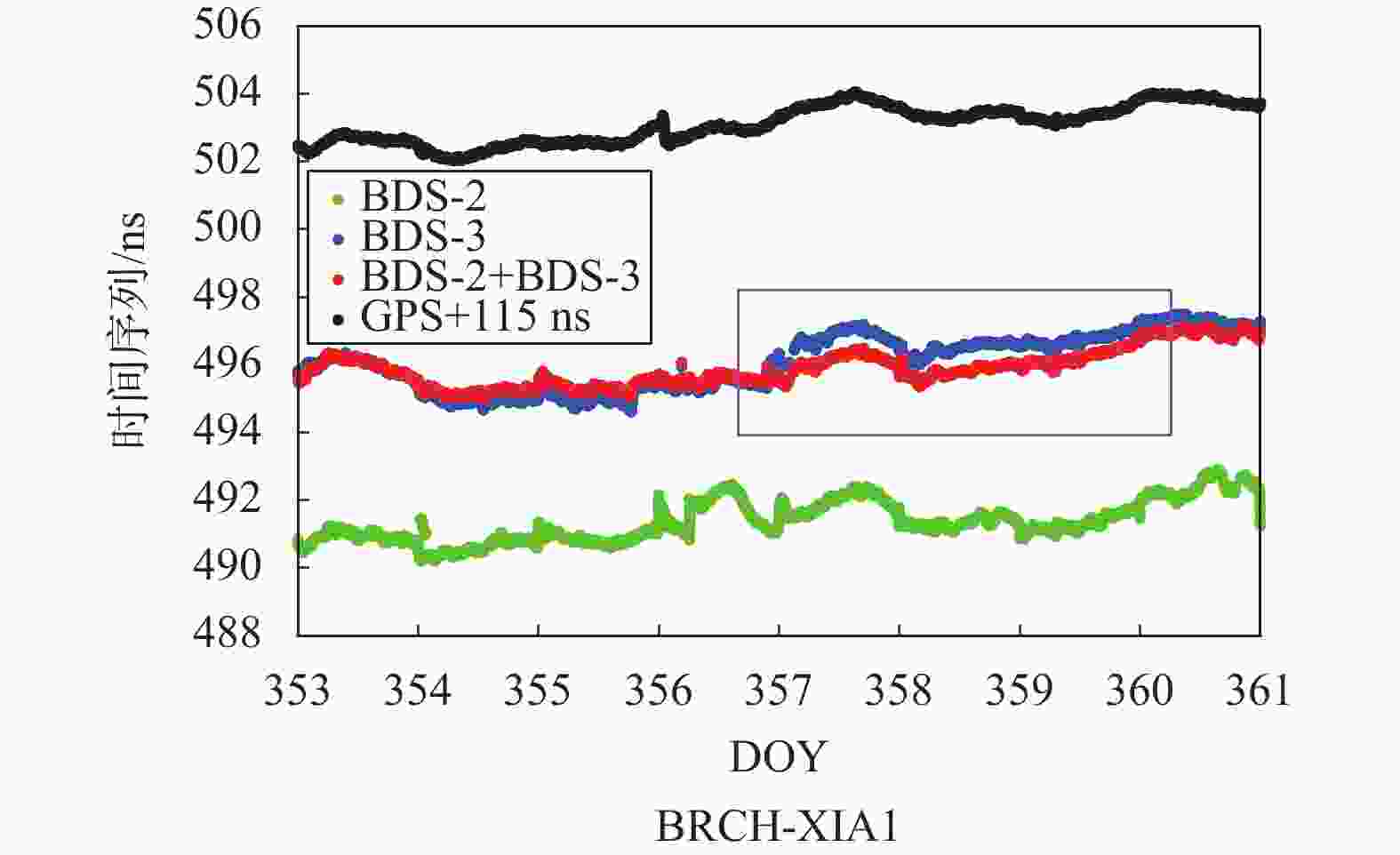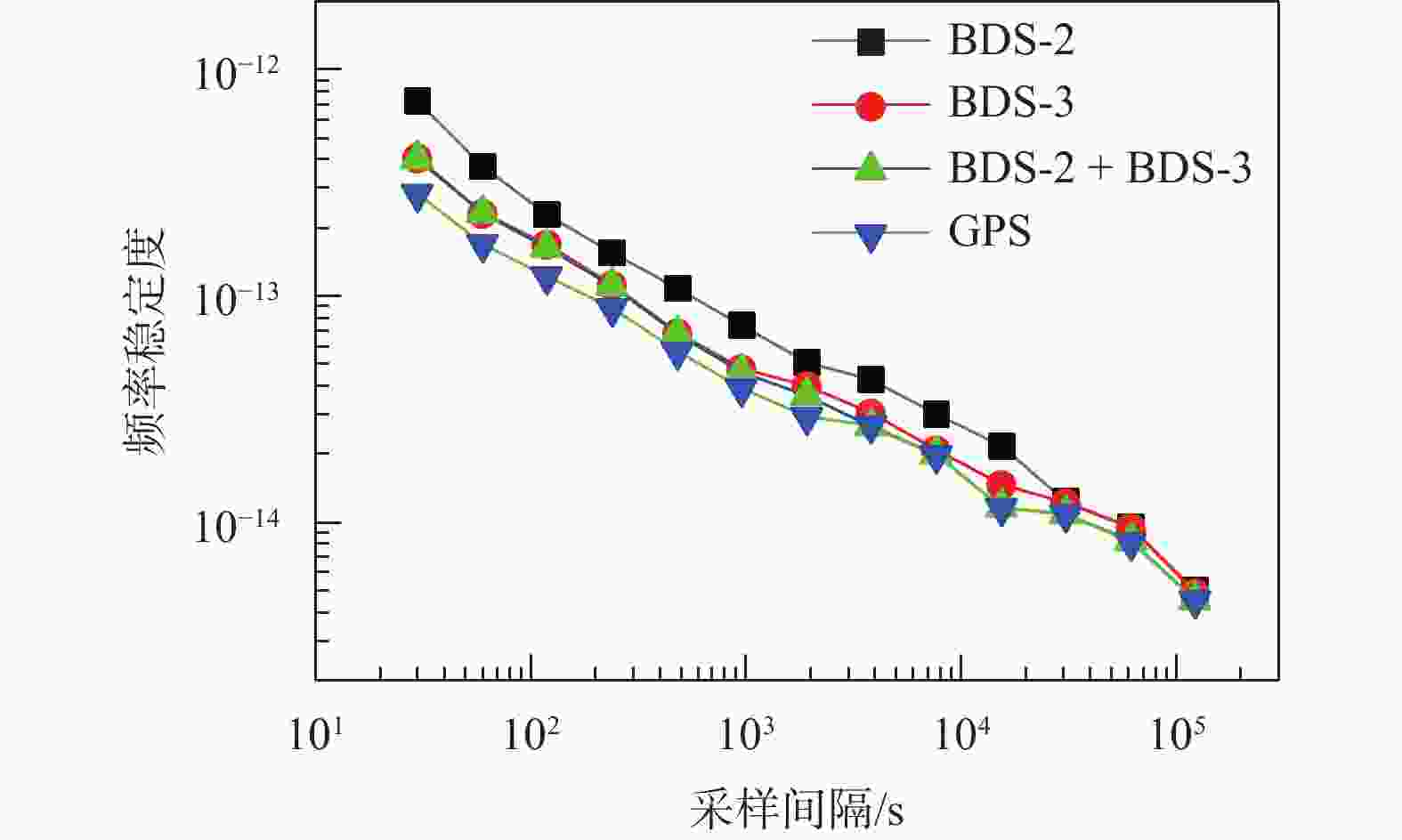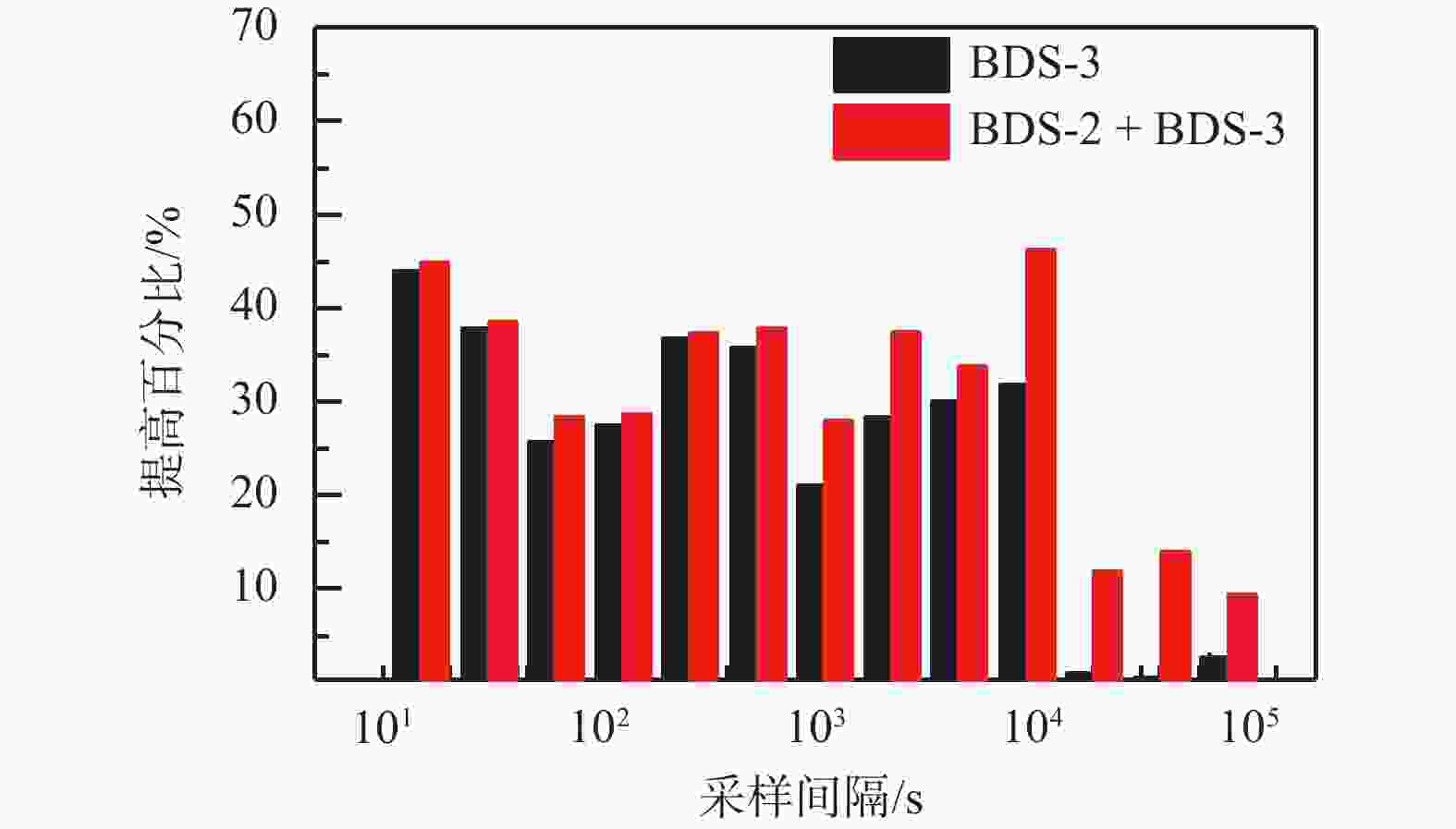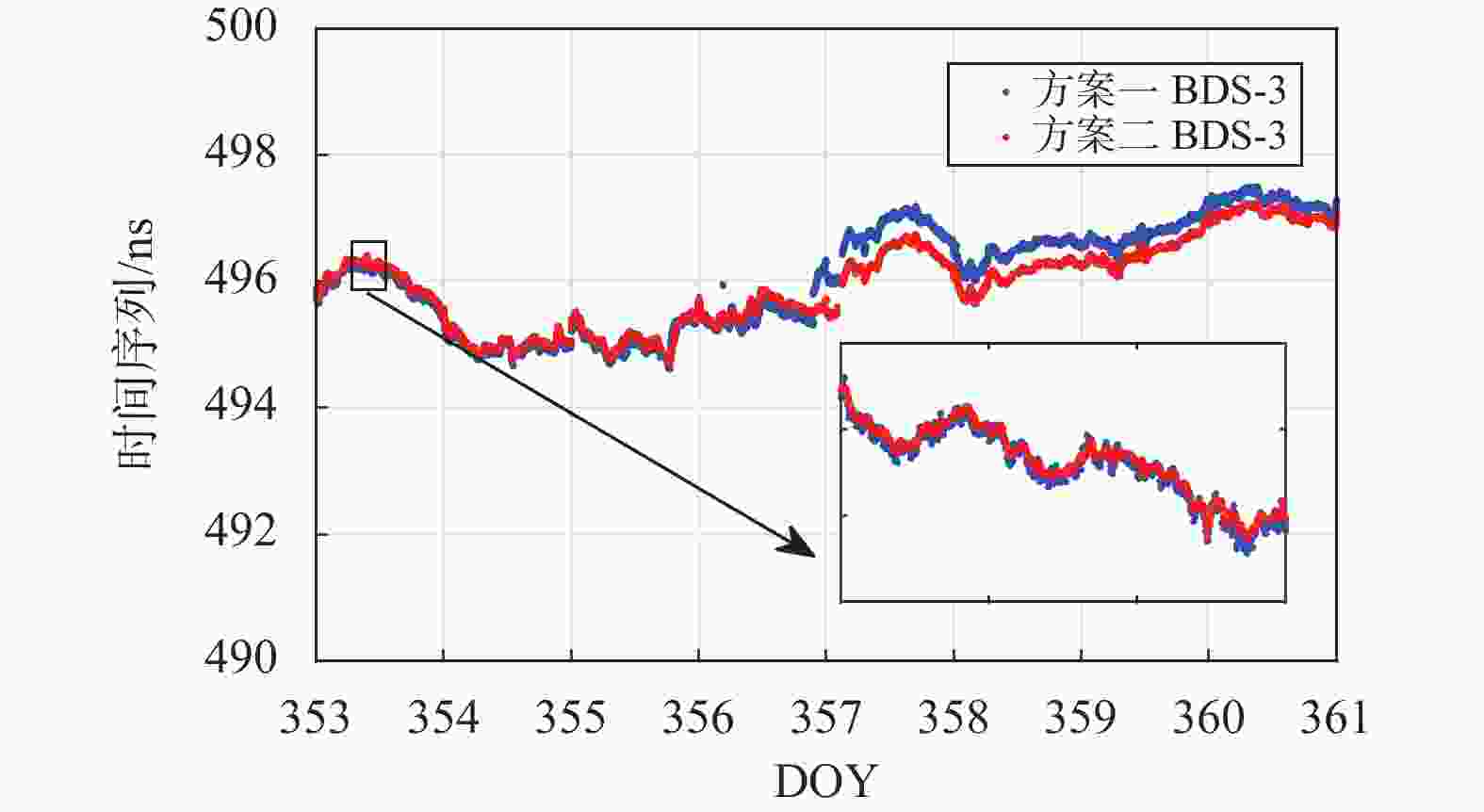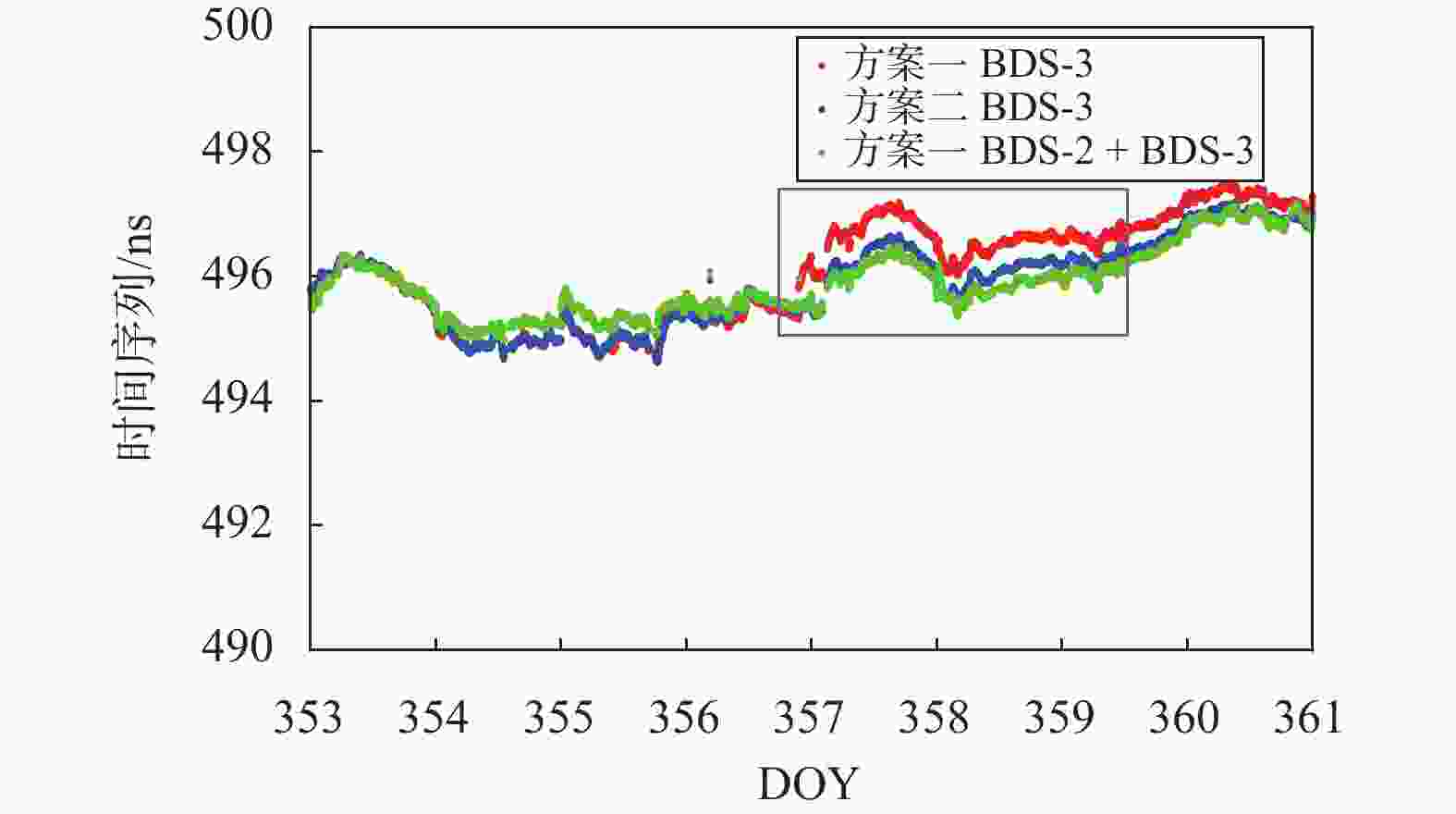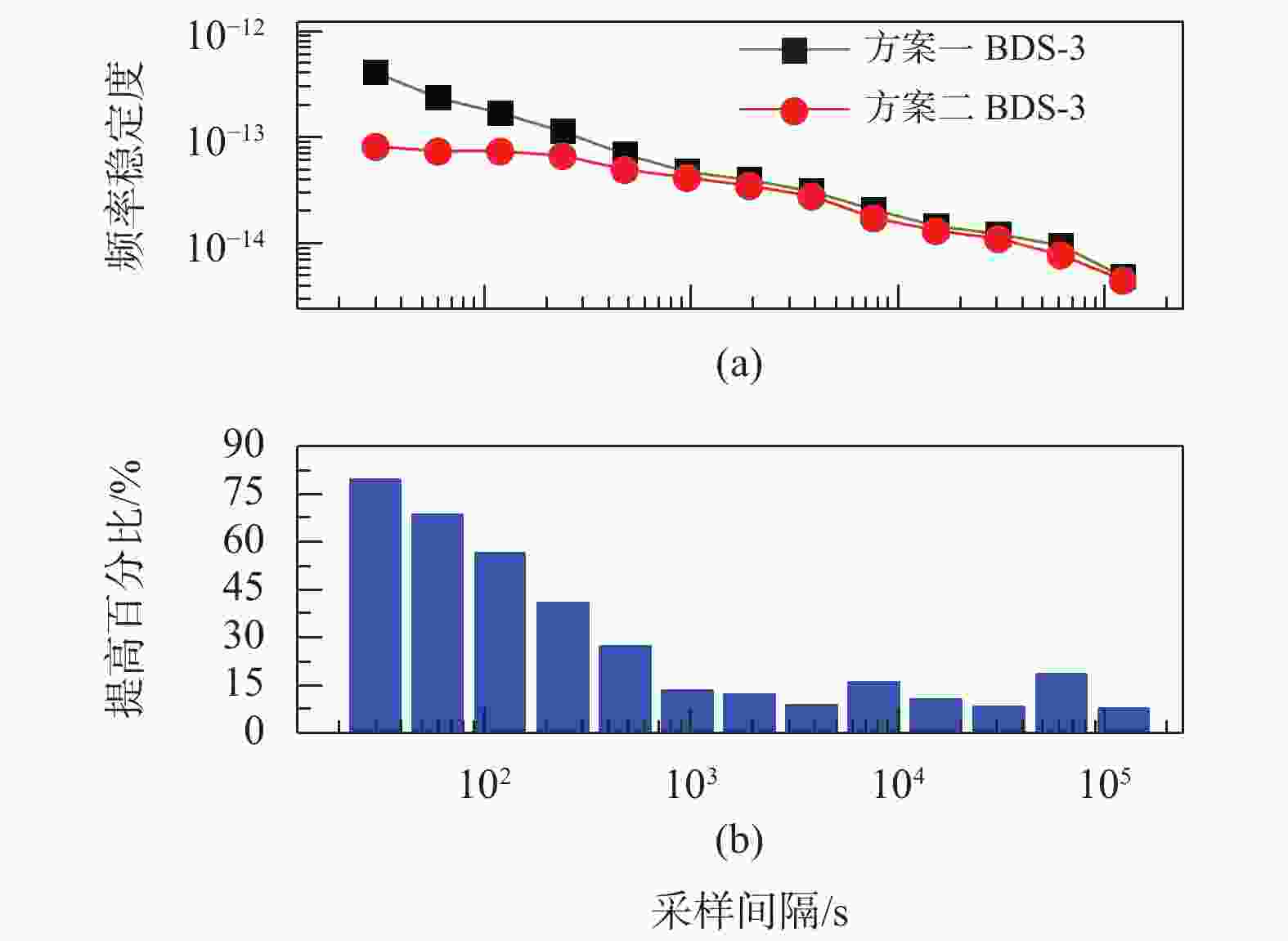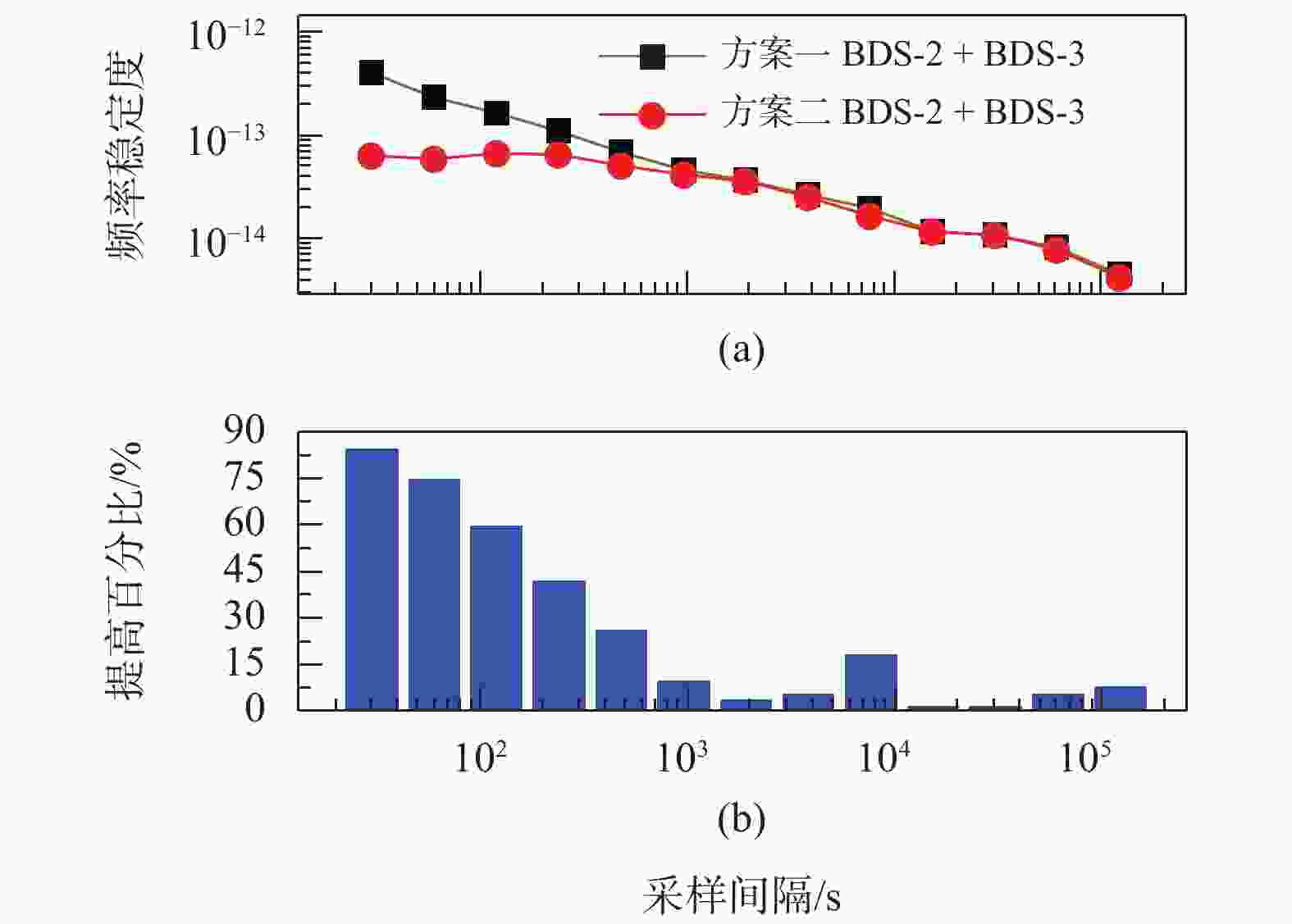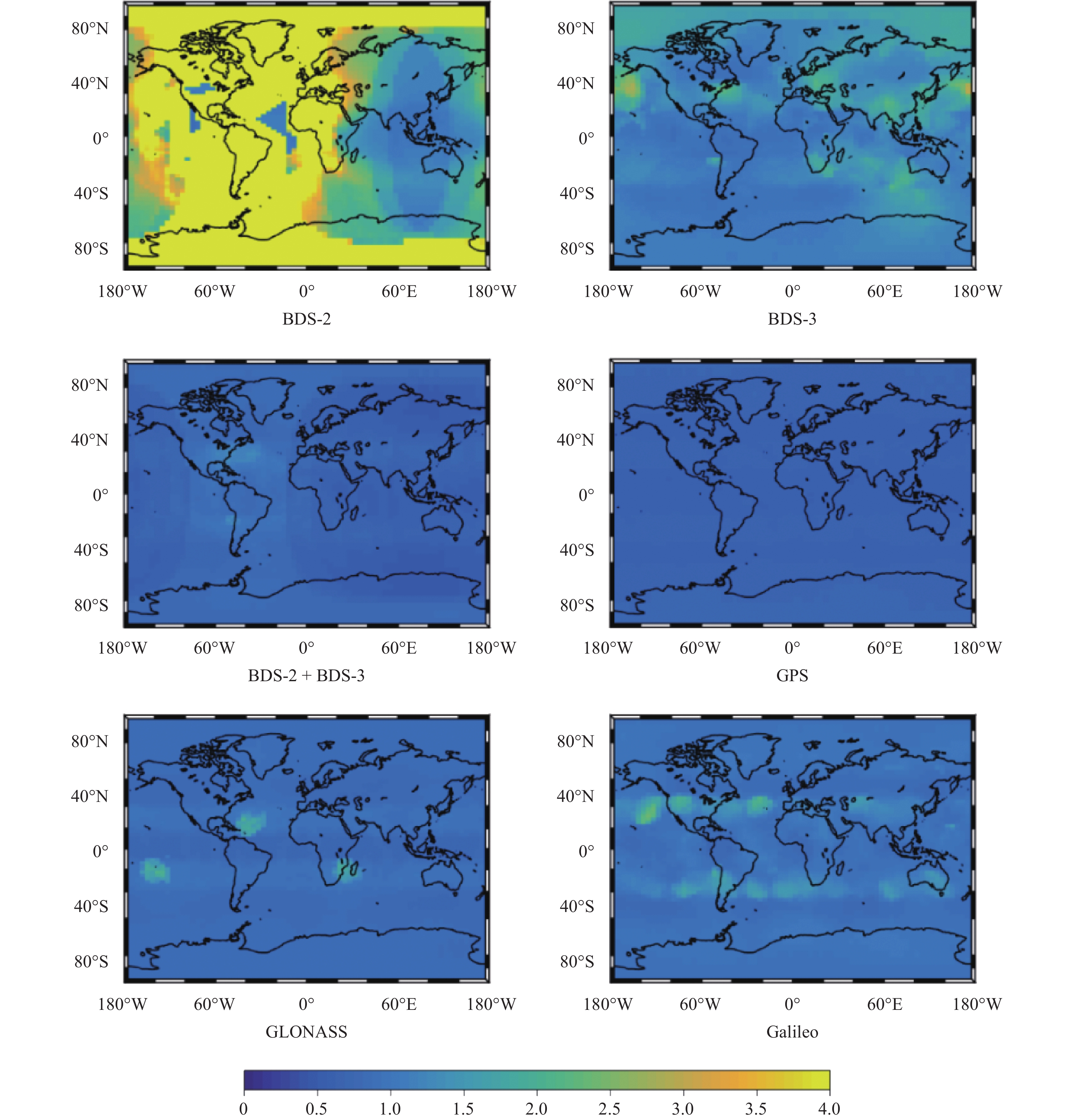Comprehensive performance analysis of BDS-3 precise point positioning time transfer
-
摘要: 我国北斗三号卫星导航系统(BDS-3)的建设已基本完成,因而,充分利用当前BDS-3进行精密单点定位(PPP)的时间传递亟需深入研究. 本文从两方面来充分研究BDS-3 PPP时间传递:1)北斗二号卫星导航系统(BDS-2)、BDS-3和BDS-2+BDS-3 PPP时间传递;2)钟模型约束的BDS-3 PPP时间传递. 试验结果表明:相比BDS-2 PPP,BDS-3和BDS-2+BDS-3 PPP结果平滑残差的均方根(RMS)值可减少约为34.5%和38.23%,960 s的稳定度分别提高35.81%和37.75%;相比传统的白噪声(WN)模型,基于钟模型的BDS-3和BDS-2+BDS-3 PPP时间传递所得平滑残差RMS值分别减少65.17%和74.42%;频率稳定度最大可提高80%.
-
关键词:
- 北斗三号卫星导航系统(BDS-3) /
- 精密单点定位(PPP) /
- 时间传递 /
- 原子钟模型 /
- 北斗二号卫星导航系统(BDS-2)
Abstract: The construction of China’s BeiDou-3 Navigation Satellite System (BDS-3) has been basically completed. Therefore, full use of the current BDS-3 satellite for precise point positioning (PPP) time transfer requires urgent research. This article analyzes BDS-3 PPP time transfer in two aspects. 1) BeiDou-2 Navigation Satellite System (BDS-2), BDS-3 and BDS-2+BDS-3 PPP time transfer. 2) Clock model constrained BDS-3 PPP time transfer. The results show that the root mean squares (RMS) values of smoothed residual value obtained by BDS-3 and BDS-2+BDS-3 PPP can be reduced by 34.5% and 38.23%, the frequency stability of 960 s is increased by 35.81% and 37.75% respectively, compared with BDS-2 PPP; compared with the traditional white noise model, the RMS values of the smoothed residual obtained by BDS-3 and BDS-2+BDS-3 PPP time transfer with the clock model is reduced by 65.17% and 74.42%; in addition, frequency stability can be increased up to 80%. -
表 1 PPP计算的时间序列与平滑值的差值RMS
ns 差值 BDS-2 BDS-3 BDS-2+BDS-3 GPS RMS 0.013 6 0.008 9 0.008 4 0.008 3 表 2 基于两种方案得到的时间序列与平滑值的差值RMS
模型 方案一/ns 方案二/ns 提升百分比 /% BDS-3 0.008 9 0.003 1 65.17 BDS-2+BDS-3 0.008 4 0.002 4 74.42 -
[1] ALLAN D W, WEISS M A. Accurate time and frequency transfer during common-view of a GPS satellite[C]//The 34th Annual Symposium on Frequency Control, 1980: 334-356. DOI: 10.1109/FREQ.1980.200424 [2] DAI P P, GE Y L, QIN W J, et al. BDS-3 time group delay and its effect on standard point positioning[J]. Remote sensing, 2019, 11(15): 1819. DOI: 10.3390/rs11151819 [3] DEFRAIGNE P, BAIRE Q. Combining GPS and GLONASS for time and frequency transfer[J]. Advances in space research, 2011, 47(2): 265-275. DOI: 10.1016/j.asr.2010.07.003 [4] PETIT G, JIANG Z H. Precise point positioning for TAI computation[C]//International Journal of Navigation and Observation, 2008. DOI: 10.1155/2008/562878 [5] GE Y L, ZHOU F, LIU T J, et al. Enhancing real-time precise point positioning time and frequency transfer with receiver clock modeling[J]. GPS solutions, 2018, 23(1):20. DOI: 10.1007/s10291-018-0814-y [6] GE Y L, DAI P P, QIN W J, et al. Performance of Multi-GNSS precise point positioning time and frequency transfer with clock modeling[J]. Remote sensing, 2019, 11(3): 347. DOI: 10.3390/rs11030347 [7] GE Y L, DING S, QIN W J, et al. Carrier phase time transfer with Galileo observations[J]. Measurement, 2020(159): 107799. DOI: 10.1016/j.measurement.2020.107799 [8] JIAO G Q, SONG S L, JIAO W H. Improving BDS-2 and BDS-3 joint precise point positioning with time delay bias estimation[J]. Measurement science and technology, 2020, 31(2): 025001. DOI: 10.1088/1361-6501/ab41cf [9] LI X X, YUAN Y Q, ZHU Y T, et al. Precise orbit determination for BDS-3 experimental satellites using iGMAS and MGEX tracking networks[J]. Journal of geodesy, 2018, 93(1): 103-117. DOI: 10.1007/s00190-018-1144-0 [10] LI X X, XIE W L, HUANG J X, et al. Estimation and analysis of differential code biases for BDS-3/BDS-2 using iGMAS and MGEX observations[J]. Journal of geodesy, 2018, 93(3): 419-435. DOI: 10.1007/s00190-018-1170-y [11] PETIT G, JIANG Z. GPS all in view time transfer for TAI computation[J]. Metrologia, 2007, 45(1): 35-45. DOI: 10.1088/0026-1394/45/1/006 [12] PETIT G. The TAIPPP pilot experiment[C]//IEEE International Frequency Control Symposium Joint with the 22nd European Frequency and Time Forum, 2009. DOI: 10.1109/FREQ.2009.5168153 [13] PETIT G, KANJ A, LOYER S, et al. 1×10−16 frequency transfer by GPS PPP with integer ambiguity resolution[J]. Metrologia, 2015, 52(2): 301-309. DOI: 10.1088/0026-1394/52/2/301 [14] PIESTER D, BAUCH A, BECKER J, et al. Two-way satellite time transfer between USNO and PTB[C]//IEEE International Frequency Control Symposium and Exhibition, 2005. DOI: 10.1109/FREQ.2005.1573952 [15] QIN W J, GE Y L, WEI P, et al. Assessment of the BDS-3 on-board clocks and their impact on the PPP time transfer performance[J]. Measurement, 2019, 153(2): 107356. DOI: 10.1016/j.measurement.2019.107356 [16] QIN W J, GE Y L, ZHANG Z, et al. Accounting BDS3–BDS2 inter-system biases for precise time transfer[J]. Measurement, 2020, 156(1): 107566. DOI: 10.1016/j.measurement.2020.107566 [17] RAY J, SENIOR K. IGS/BIPM pilot project: GPS carrier phase for time/frequency transfer and timescale formation[J]. Metrologia, 2003, 40(3): s270-s288. DOI: 10.1088/0026-1394/40/3/307 [18] SU K, JIN S G. Triple-frequency carrier phase precise time and frequency transfer models for BDS-3[J]. GPS solutions, 2019, 23(3): 86. DOI: 10.1007/s10291-019-0879-2 [19] TU R, ZHANG P F, ZHANG R, et al. Modeling and performance analysis of precise time transfer based on BDS triple-frequency un-combined observations[J]. Journal of geodesy, 2018, 93(12): 837-847. DOI: 10.1007/s00190-018-1206-3 [20] YANG Y X, GAO W G, GUO S R, et al. Introduction to BeiDou-3 Navigation Satellite System[J]. Navigation, 2019, 66(1): 7-18. DOI: 10.1002/navi.291 [21] YANG Y X, MAO Y, SUN B J. Basic performance and future developments of BeiDou Global Navigation Satellite System[J]. Satellite navigation, 2020, 1(1): 1. DOI: 10.1186/s43020-019-0006-0 [22] ZHANG P F, TU R, ZHANG R, et al. Combining GPS, BeiDou, and Galileo satellite systems for time and frequency transfer based on carrier phase observations[J]. Remote sensing, 2018, 10(2): 324. DOI: 10.3390/rs10020324 [23] ZHANG P F, TU R, ZHANG R, et al. Time and frequency transfer using BDS-2 and BDS-3 carrier phase observations[J]. IET radar, sonar and navigation, 2019, 13(8): 1249-1255. DOI: 10.1049/iet-rsn.2019.0011 [24] ZHANG P F, TU R, GAO Y P, et al. Performance of Galileo precise time and frequency transfer models using quad-frequency carrier phase observations[J]. GPS solutions, 2020, 24(2). DOI: 10.1007/s10291-020-0955-7 [25] ZHANG Z T, LI B F, NIE L W, et al. Initial assessment of BeiDou-3 Global Navigation Satellite System: signal quality, RTK and PPP[J]. GPS solutions, 2019, 23(4): 111. DOI: 10.1007/s10291-019-0905-4 [26] 陈宪冬. 基于大地型时频传递接收机的精密时间传递算法研究[J]. 武汉大学学报(信息科学版), 2008, 33(3): 245-248. [27] 吕大千, 曾芳玲, 欧阳晓凤, 等. 时频传递的改进整数相位钟方法[J]. 测绘学报, 2019, 48(7): 889-897. [28] 闫伟, 袁运斌, 欧吉坤, 等. 非组合精密单点定位算法精密授时的可行性研究[J]. 武汉大学学报(信息科学版), 2011, 36(6): 648-651. [29] 于合理, 郝金明, 刘伟平, 等. 附加原子钟物理模型的PPP时间传递算法[J]. 测绘学报, 2016, 45(11): 1285-1292. DOI: 10.11947/j.AGCS.2016.20160217 [30] 张小红, 蔡诗响, 李星星, 等. 利用GPS精密单点定位进行时间传递精度分析[J]. 武汉大学学报(信息科学版), 2010, 35(3): 274-278. [31] 张小红, 陈兴汉, 郭斐. 高性能原子钟钟差建模及其在精密单点定位中的应用[J]. 测绘学报, 2015, 44(4): 392-398. DOI: 10.11947/j.AGCS.2015.20140287 -




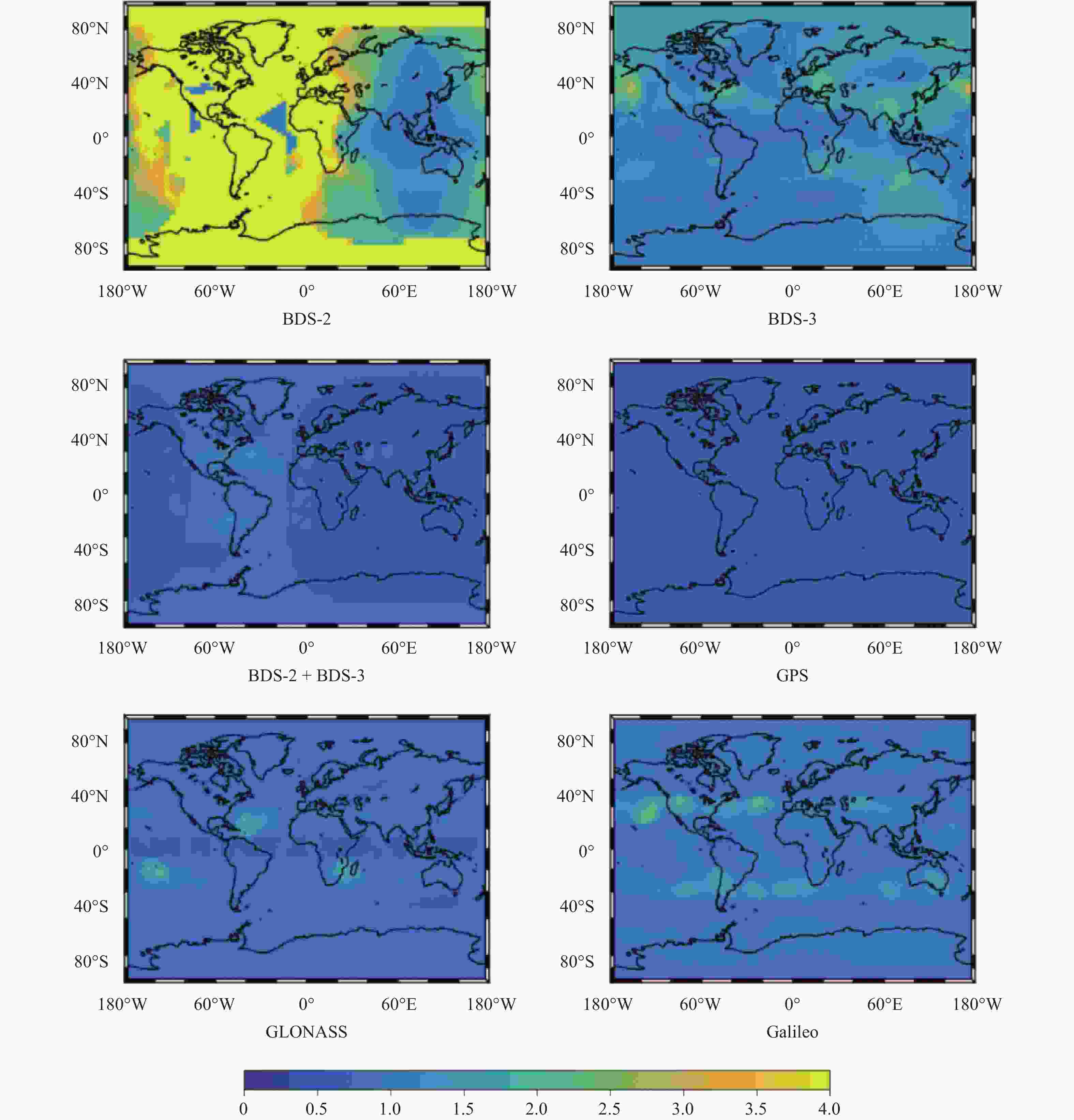
 下载:
下载:

